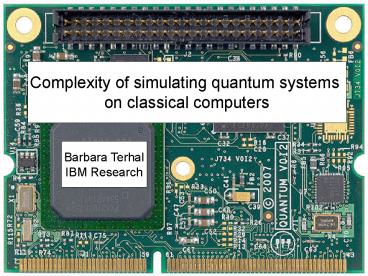Complexity of simulating quantum systems - PowerPoint PPT Presentation
Title:
Complexity of simulating quantum systems
Description:
Complexity of simulating quantum systems on classical computers Barbara Terhal IBM Research Computational Quantum Physics Physically-Relevant Quantum States Efficient ... – PowerPoint PPT presentation
Number of Views:165
Avg rating:3.0/5.0
Title: Complexity of simulating quantum systems
1
Complexity of simulating quantum systems on
classical computers
Barbara Terhal IBM Research
2
Computational Quantum Physics
- Computational quantum physicists (in
condensed-matter physics, quantum chemistry etc.)
have been in the business of showing how to
simulate and understand properties of many-body
quantum systems using a classical computer. - Heuristic and ad-hoc methods dominate, but the
claim has been that these methods often work well
in practice. - Quantum information science has and will
contribute to computational - quantum physics in several ways
- Come up with better simulation algorithms
- Make rigorous what is done heuristically/approxim
ately in computational physics. - Delineate the boundary between what is possible
and what is not. That is - show that certain problems are hard for classical
(or even quantum) computers - in a complexity sense.
3
Physically-Relevant Quantum States
local interactions are between O(1) degrees of
freedom (e.g. qubits)
4
Efficient Classical Descriptions
5
Matrix Product States
6
1st Generalization Tree Tensor Product States
7
2nd Generalization Tensor Product States or PEPS
8
Properties of MPS and Tree-TPS
9
Properties of tensor product states
PEPS and TPS perhaps too general for classical
simulation purposes
10
Quantum Circuit Point of View
Past Light Cone
Max width
11
Quantum Circuit Point of View
12
Quantum Circuit Point of View
13
Area Law
14
Classical Simulations of Dynamics
15
Lieb-Robinson Bounds
Lieb-Robinson Bound Commutator of operator A
with backwards propagated B decays
exponentially with distance between A and B,
when A is outside Bs effective past light-cone.
Bulk Past Light Cone
A
B
16
Stoquastic Hamiltonians
17
Examples of Stoquastic Hamiltonians
Particles in a potential Hamiltonian is a sum
of a diagonal potential term in position xgt and
off-diagonal negative kinetic terms
(-d2/dx2). All of classical and quantum
mechanics. Quantum transverse Ising model
Ferromagnetic Heisenberg models (modeling
interacting spins on lattices) Jaynes-Cummings
Hamiltonian (describing atom-laser interaction),
spin-boson model, bosonic Hubbard models,
Bose-Einstein condensates etc. D-Waves Orion
quantum computer Non-stoquastic are typically
fermionic systems, charged particles in a
magnetic field. Stoquastic Hamiltonians are
ubiquitous in nature. Note that we only consider
ground-state properties of these Hamiltonians.
18
Stoquastic Hamiltonians
19
Frustration-Free Stoquastic Hamiltonians
20
Conclusion

